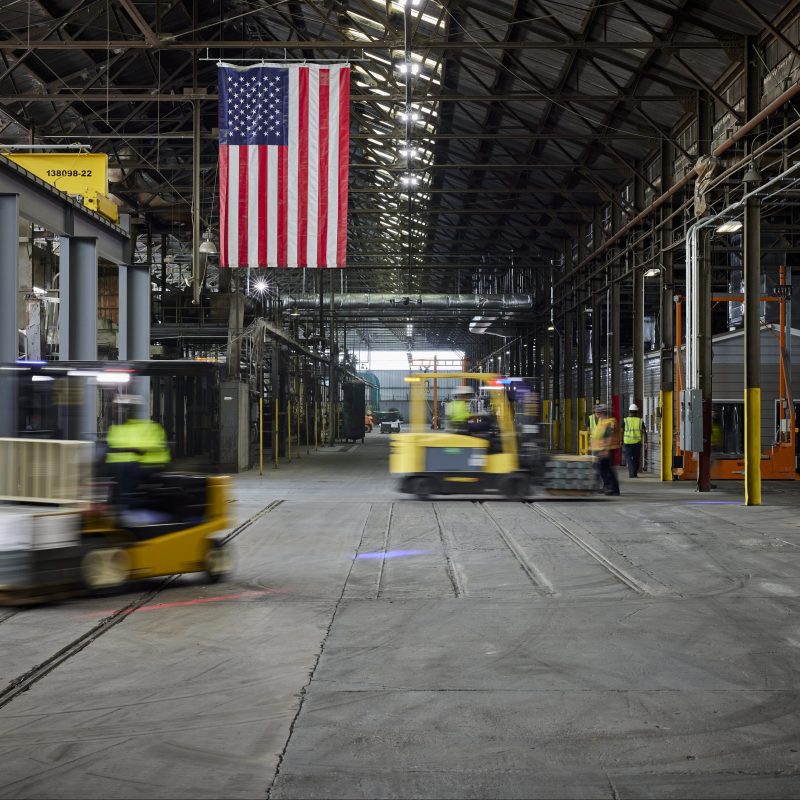FAIRFIELD, Ala. – The shuttered plant was in rough shape.
During a 2021 visit to check the condition of the idled plant, which once manufactured refractory products used for aluminum production, HarbisonWalker International representatives Kevin Ballard and Jason West came upon a scene where Mother Nature was winning.
Ballard, vice president of operations and engineering, recalled the visit in June.
“Weeds were high, and some pigeons had found homes in the rafters,” Ballard said.
West, director of engineering and maintenance, who lives in nearby Jasper, worked at the location before it closed.
“After working there for so long, you remembered all the people and everything moving around when you walked in,” he said.
“You could hear a pin drop.”
But as Ballard and West walked the vacant plant that day, they envisioned its potential.
Ballard and West’s trip to the former Alabama plant was a part of HWI’s company-wide initiative to respond to a surge in new steel production facilities in the southern United States. With a Michigan plant running to full capacity to fulfill increasing steel demands, the two men realized that with a major refurbishing effort, a problem could be solved in this small town a short distance from downtown Birmingham.
Although other sites were considered, HWI announced in early 2022 it would convert the property into a manufacturing, service, and distribution hub for southern U.S. steel customers. The company eventually invested more than $35 million in the 200,000-square-foot space that re-opened as HWI’s “AL1” plant in late December 2022.
Shortly after the re-opening, Platinum Equity completed the acquisition of HWI, and began merging the company with Calderys, a global provider for industries operating in high-temperature conditions. HWI has officially rebranded as ‘HWI, a member of Calderys’ and is now the brand for the Americas region in the group. AL1 was a natural place for Platinum Equity executives to meet with Calderys and HWI leadership in late June.
Ross Wilkin, senior vice president of the Americas region of Calderys, calls the new facility “remarkable.”
“We were able to revitalize an obsolete facility and create a full-service hub to better serve our customers in the South while advancing technologies and our environmental commitments – all at a cost of slightly more than $35 million,” Wilkin said. “If we were to build an entirely new space, it would have cost us more than double that amount.
“AL1 is a remarkable story of renewal, innovation, sustainability and customer responsiveness.”
Currently, the facility employs approximately 30, with plans to employ up to 50 people. The plant will eventually produce 30,000 metric tons of refractory bricks per year.
Refractory materials are vital for steel production
Refractory materials are used by virtually every industry that requires manufacturing in high temperatures. Think glass, cement, aluminum – and steel.
“The refractory world is in everything we touch, you just don’t always think about it or know it,” West said. “Steel is all around us. The roads, the bridges you drive on. The signs that showed you how to get here, the plane that flew you down here.”
While a decline in the aluminum market led to the Alabama facility’s closure in 2019, U.S. steelmakers’ growing demands resulted in reaching full capacity at HWI’s Michigan plant a couple of years later.
Located in White Cloud, a town north of Grand Rapids on the west side of the state, the plant currently produces 90,000 metric tons per year. After the passing of the $1.2 trillion Infrastructure Investment and Jobs Act in 2021, the American Iron and Steel Institute, an association of North American steel producers, estimated 5 million metric tons of steel will be needed for every $100 billion of direct infrastructure spending in the legislation.
The bill also dictates that steel produced in the U.S. must be used for infrastructure projects. This implied a growing need of refractory products, especially magnesia carbon bricks, from southern steel producers to protect their furnaces from molten steel that would otherwise melt production containers.
“Our White Cloud plant was working seven days a week, 365 days a year, and products needed to be shipped the distance to customers’ new southern locations,” Ballard said. “Repurposing the Alabama facility aligned perfectly with the steelmaking expansion in the South.”
The new facility addresses HWI’s commitment to environmental responsibility while utilizing some of the most advanced manufacturing processes for brick refractories. From raw material entry to robotic presses and packaging, its automated processes are expected to result in high-quality control and production efficiencies.
Adding to its environmentally sound features, the facility was revitalized under Alabama Brownfield redevelopment regulations. HWI refurbished the plant with managing resources in mind, including energy savings measures and electric lift trucks. Ballard credits the HWI engineering team for completing most of the extensive overhaul in such a short period of time.
“Our strategic location to customers means a reduction in our carbon footprint since we’re using less fuel to ship products,” West said.
Quality assurance manager Ben Baxter said: “Efficiencies are everywhere here. Our teams can run most of our operations through the touch of an iPad.”
The plant renewal brought media coverage and local officials praised HWI.
“We are excited to work with HarbisonWalker International to bring jobs to the Fairfield area of Jefferson County,” Jefferson County commissioner Steve Ammons said in a news release. “Providing more and better opportunities for our citizens is our goal in working with companies and municipalities.”



